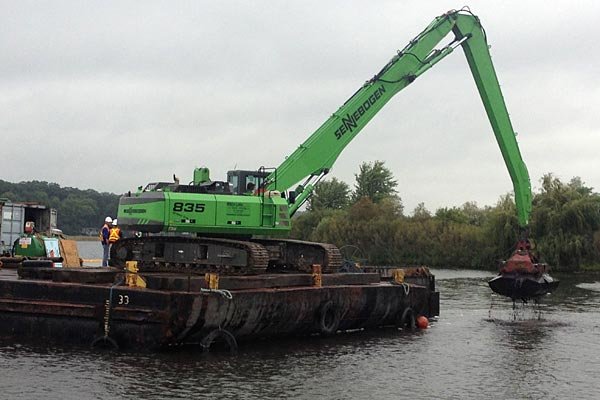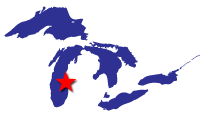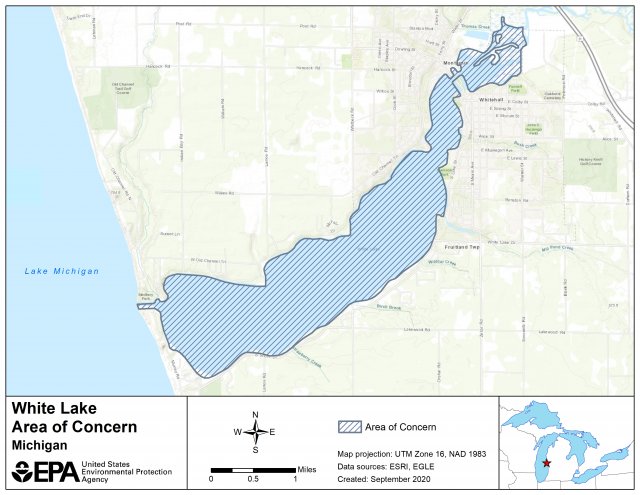White Lake AOC - Delisted
Gerardo Caballero Manriquez
(caballeromanriquez.gerardo@epa.gov)
312-353-1739
White Lake AOC was delisted in 2014.
Overview
White Lake is located in Muskegon County along the eastern shore of Lake Michigan. In 1987, it was declared a Great Lakes Area of Concern under the Great Lakes Water Quality Agreement. In 2014, White Lake was removed from the binational list of AOCs after years of remediation and restoration work improved environmental conditions in the lake. The Michigan Department of Environment, Great Lakes, and Energy continues to monitor White Lake.
A long history of chemical manufacturing, waste disposal practices, municipal wastewater discharges, tannery operations, and other activities contributed to the degradation of White Lake. The major environmental problems affecting the lake at the time of listing were contaminated groundwater discharges to the lake, heavy metals and other compounds contaminating sediment, and excess nutrients from municipal wastewater discharges. Since the designation of AOC, a variety of public and private remediation and restoration efforts have led to improvement in overall water quality and the removal of BUIs.
The White Lake AOC includes White Lake proper and a source area zone of 0.4 km (0.25 mi) around the lake.
Beneficial Use Impairments
Removing Beneficial Use Impairments is a key measure for demonstrating success in improving environmental conditions at an AOC. Beneficial use impairments are designations given by the International Joint Commission representing different types of significant environmental degradation. As cleanup work is completed, and monitoring demonstrates sufficient environmental health improvements, BUIs can be removed. Out of 14 BUIs, 8 were designated for the White Lake AOC. The list below shows the removed BUIs.
- Restrictions on Dredging Activities- Removed September 2011
- Eutrophication or Undesirable Algae - Removed April 2012
- Degradation of Benthos - Removed June 2012
- Restrictions on Fish and Wildlife Consumption - Removed February 2013
- Loss of Fish and Wildlife Habitat - Removed April 2014
- Degradation of Fish and Wildlife Populations - Removed April 2014
- Restrictions on Drinking Water Consumption or Taste and Odor Problems - Removed March 2014
- Degradation of Aesthetics - Removed March 2014
More Information:
- White Lake AOC Final Delisting Report and BUI Removal Packages
- Beneficial Use Impairments for the Great Lakes AOCs
- Great Lakes Areas of Concern: Life After Delisting
Remediation and Restoration Work
After nearly three decades of monitoring, planning, and implementing remedial actions, the White Lake AOC was delisted in 2014. Prior to delisting, EPA, along with the State of Michigan, Muskegon Conservation District, the White Lake Public Advisory Council, federal partners, and others, did extensive work to address the BUIs within the AOC including: removing contaminated sediments; restoring shoreline habitat; fish surveys; and investigating other potential environmental impairments. Over 100,000 cubic yards of sediment contaminated by past industrial action were removed from the AOC. EPA and partners also restored over 50 acres of critical wetland, riparian, and nearshore habitat with the goal of revitalizing fish and wildlife populations within the AOC.
- Documents on Restoring the White Lake AOC
- Remediation and Restoration Projects for the White Lake AOC
Restoration Project Highlight: Habitat Restoration Project
In 2012, EPA partnered with the Muskegon Conservation District and the White Lake Public Advisory Council to complete the GLRI-funded, White Lake AOC Shoreline Habitat Restoration Project. The project restored shoreline, wetland, and habitat corridors at 10 public and private sites surrounding White Lake. EPA and partners also engaged the surrounding communities and provided information on shoreline practices and their relationship to fishery and wildlife health through an opening ceremony, brochures, a website, e-newsletters, informational meetings, and volunteer planting events.
Project accomplishments:
- Removed over 8,000 linear feet of shoreline
- Created or restored 38 acres of wetland habitat
- Restored nearly 15 acres of riparian and upland acres
- Removed nearly 52,000 cubic yards of shoreline/submerged debris
- Removed 500 linear feet of sheet-pile seawall
The habitat restoration project targeted these BUIs:
- Loss of Fish and Wildlife Habitat
- Degradation of Fish and Wildlife Populations
Highlighted Remediation Project: Tannery Bay Remediation
Prior to removal, sediment containing a purple discoloration along with hair and hide remnants was noted in nearshore areas within Tannery Bay. The discoloration and hide remnants resulted from the historical tannery operations that disposed of dyes and other waste in the bay. There were 2 sediment remediation projects to address sediment contamination in Tannery Bay:

- In 2002, the State of Michigan in partnership with Genesco, Inc., remediated 85,000 cubic yards of tannery waste contaminated sediment.
- In 2013, EPA using GLRI funds removed an additional 8.700 cubic yards of contaminated sediment along the Tannery Bay shoreline and covered the area with clean sand.
This project targeted the Degradation of Aesthetics BUI.
Partners
The following links exit the site



